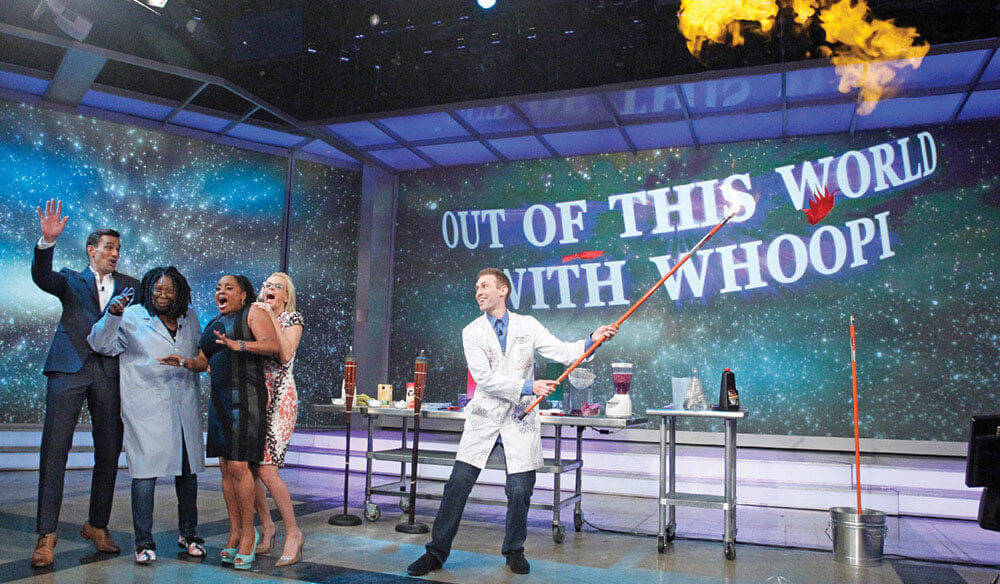
Street-Dance Scientist
Balancing competing passions, Jeff Vinokur’s whiz-bang shows — and fancy footwork — bring science to the masses.
At the tender age of twenty-four, Jeff Vinokur ’12 has an agent and a publicist. He owns a company. He appears on national and local television with regularity, mixing it up with the likes of Queen Latifah, Rachael Ray, and Whoopi Goldberg.
He is also on the horns of a dilemma.
Vinokur would love to become a working scientist, and he is well on his way to that goal. As a PhD candidate in biochemistry at UCLA, one of the top programs in the country, he prospects for better ways to harness bacteria to make biofuels.
“It’s the reaction from the kids that makes it worthwhile.”
— Jeff Vinokur
His scholarship has led to the discovery of a new biochemical pathway in an ancient lineage of microorganism, a feat he calls an accident. But the work has led to several publications — the currency of academia — and has helped establish his credibility at the lab bench. His research has resulted in two coveted fellowships, one from the National Institutes of Health and the other from the National Science Foundation, ensuring his graduate education.
Then there is Vinokur’s alter ego: the Dancing Scientist. He’s a master of popping, a street-dance style based on rapid-fire contraction and relaxation of muscles to cause a jerk or a pop in rhythm that combines with a variety of robot-like movements and poses. Vinokur is a creative and experimental scientific demonstrator, an art he was tenacious in acquiring and improving as an undergraduate at UW–Madison. He blends his dance moves with his scientific demonstration skills to amaze and entertain audiences from Washington to Singapore.
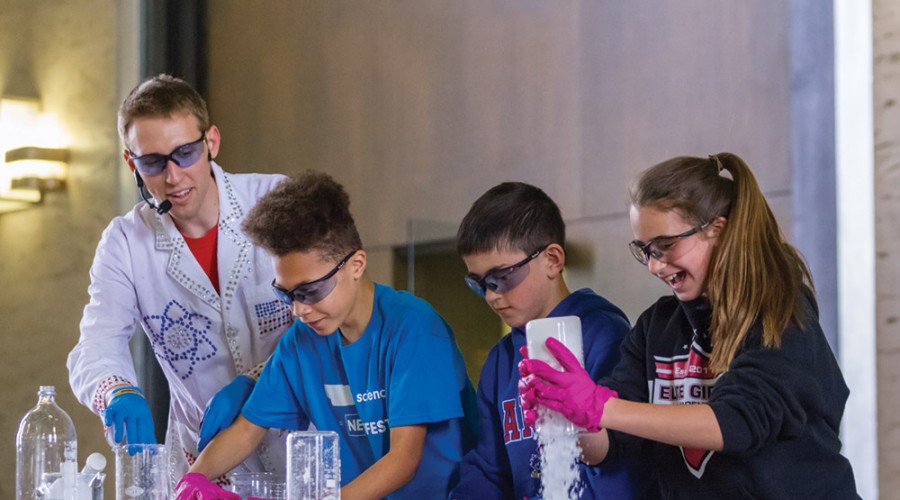
It’s hard to tell who is having the most fun as Jeff Vinokur teaches youngsters about super-absorbent polymers during a demonstration at the Nebraska Science Festival. Photo: Scott Dobry.
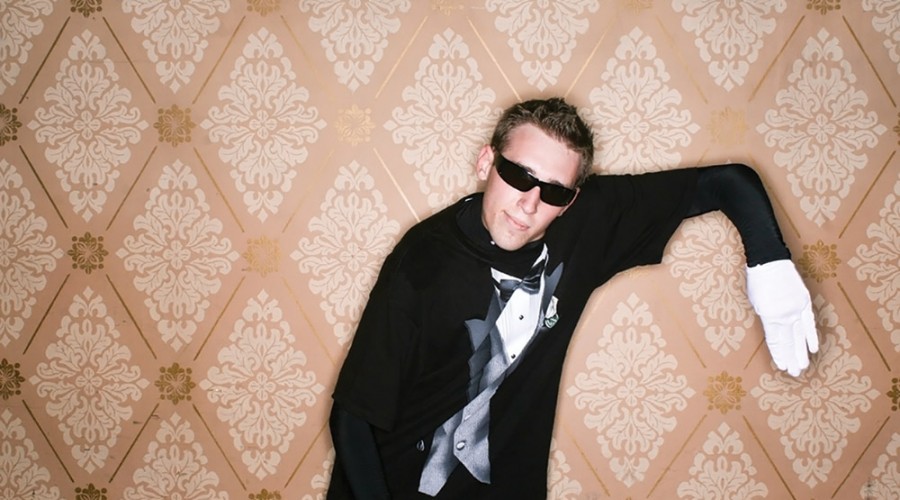
Calling upon one of his other skills Vinokur abandons his white lab coat and dances during a wedding held at the Orpheum Theatre on State Street in Madison. Courtesy of Jeff Vinokur.

Following his first performance as a guest on NBC’s Today, Vinokur’s mom captures a photo with hosts Hoda Kotb, left, and Kathie Lee Gifford. Courtesy of Jeff Vinokur.
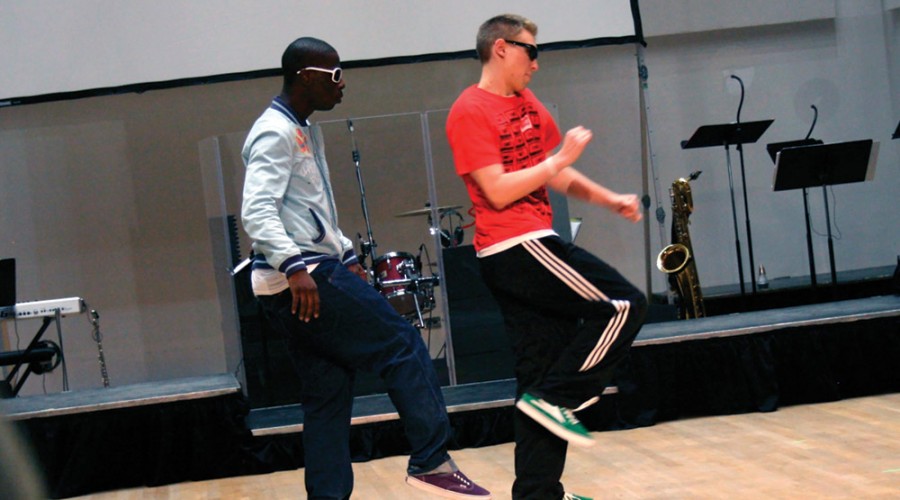
With no shortage of dance moves, Vinokur performs with James Gavins during a UW’s Got Talent event held in Mills Hall in the Mosse Humanities Building on campus. Courtesy of Jeff Vinokur.
In this persona, Vinokur has performed for tens of thousands of schoolchildren, sometimes doing three shows a day with the help of an assistant known as Stingray, whom he recruited on Craigslist. He concocts rocket fuel from Splenda, demonstrates the remarkable qualities of a nickel-titanium alloy dubbed memory metal, and makes wine glasses disappear, a stunt he performed for a clearly charmed (“Is there a Mrs. Vinokur?”) Kathie Lee Gifford on Today.
As an undergraduate, Vinokur spent his summers and breaks touring the country, working school assemblies in evangelical fashion to promote interest in science and turning enough of a profit from his entrepreneurial ventures to cover his tuition. In 2012, building on the science presentation business model, Vinokur founded Brain Mogul Education, a company with performers in San Francisco, Chicago, New York, and Washington, D.C.
His media scores include America’s Got Talent, Today (three times), The View, The Queen Latifah Show, The Rachael Ray Show, at least ten appearances on the Discovery Channel, and dozens of other local and national platforms. Vinokur’s dancing act has upward of 20 million YouTube views, and his science outreach activities have garnered more print and online coverage than most accomplished scientists receive in a lifetime.
So, what’s the problem?
“I essentially have two careers right now,” explains Vinokur. “Is it possible to do both well? I don’t know the answer to that yet, but it is a great problem to have.”
In a larger context, Vinokur’s dilemma is one confronted by many scientists, especially those in the early stages of their careers. Academic science is a blood sport. It is hypercompetitive and weighted to accomplishment in the lab and a robust publishing track record. For every young scientist offered one of the few available tenure-track positions at a large research university such as Wisconsin or UCLA, there are scores of broken dreams. The days are long and tedious. Activities outside the scope of a graduate student’s very narrow area of research — such as Vinokur’s — are often considered distractions and can be detrimental to those who aspire to be on the cutting edge of science.
Yet, Vinokur is willing to take that risk. Growing up in New Jersey as the son of Russian immigrants, he displayed a steadfast curiosity about the world and how things work. “I was always into science,” he says. “As a kid, I chased bugs, mixed things up in the kitchen. I was on the robotics team in high school.”
He seems happiest when he is engaging the public, showing children, especially, the wonder and fun — and knowledge — that can be accrued through controlled explosions, colorful reactions, and the chemical and physical properties that nature confers on so many different materials, elements, and compounds.
“As a scientist, I can’t quantify it,” he says of the kicks he gets sharing scientific marvels. “It’s the reaction from the kids that makes it worthwhile. If in twenty or thirty years some of these kids follow through on a career or just have a deeper interest in science, that means I win.”
There is much more to effective science demonstration than simply blowing things up. As a student at the UW, Vinokur learned from sages such as chemistry professor Bassam Shakhashiri and physics professor emeritus Clint Sprott MA’66, PhD’69, both of whom pack auditoriums for their popular science-education spectacles.
When he was a sophomore, Vinokur approached the chemistry department’s master demonstrator Jim Maynard ’00 for training in safely conducting chemical demonstrations. “He was very persistent, and I once asked him if he was stalking me,” recalls Maynard, who nominated Vinokur for a University Book Store scholarship his senior year. “He is a self-motivated person, and I think he would have reached his goals whether I helped him or not.”
For now, Vinokur remains conflicted. “It’s cool to be the first person to know something,” he says about a career as a working scientist. “But how many people will read that paper? Ten? Twelve? You’re just one person contributing to the mountain of knowledge.”
Through performance, Vinokur thinks he can change people’s perception of science. The ideal, he says, would be to become a mass-science popularizer on the order of a Bill Nye the Science Guy. But ever the astute researcher, Vinokur knows that the market for such heavy-hitters is vanishingly small.
With fellowships covering his lab salary and encouragement from his mentor at UCLA, the Dancing Scientist has found room to transcend the brutal time commitments science requires of its graduate student acolytes. For the time being, he can continue to spread the gospel of science to school-age kids and science-festival audiences. But he’s not sure the Dancing Scientist shtick will work when he is fifty or sixty years old. He has already endured three knee surgeries related to his performance art.
Vinokur is keenly sensitive to the friction between his desire to change the world by bringing science to the masses and the thrill of discovery that comes from long hours in the laboratory of bleeding-edge science. But he is undeterred. “I like doing both,” he says. “I don’t think I’d be happy without either.”
Terry Devitt ’78, MA’85 is UW–Madison’s director of research communications. When he was a child, his chemistry set was more a danger to the community than a means of science education.
Published in the Summer 2015 issue
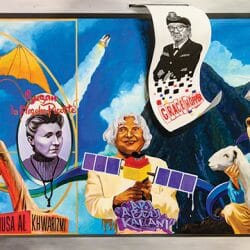
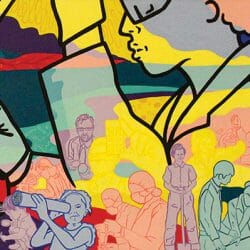

Comments
No comments posted yet.